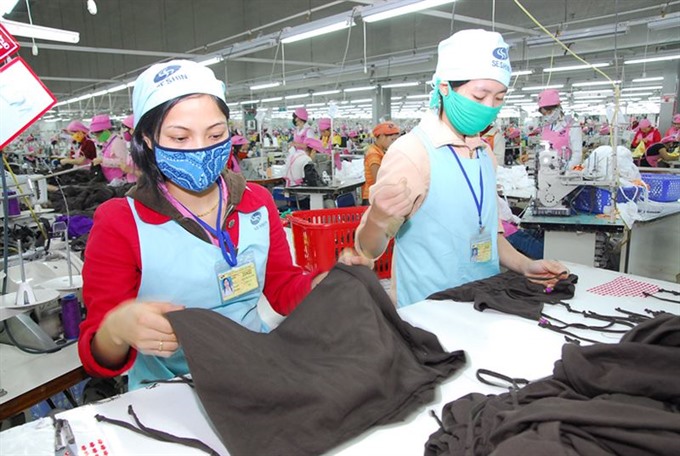 Economy
Economy

According to the ASEAN Trade in Goods Agreement (ATIGA), Việt Nam will have to cut 669 tariff lines to zero per cent in January 2018.
 |
| According to the ASEAN Trade in Goods Agreement (ATIGA), Việt Nam will have to cut 669 tariff lines to zero per cent in January 2018. — Photo baodautu.vn |
According to the ASEAN Trade in Goods Agreement (ATIGA), Việt Nam will have to cut 669 tariff lines to zero per cent in January 2018.
Among the products are automobiles and spare parts, vegetable oil, refrigerators, air conditioners and dairy products.
ATIGA promises great opportunities for the country, including exports of many products the country has advantages to other members of the bloc without or very low import tariffs.
Besides, Vietnamese businesses and consumers will enjoy access to many new goods and have more choices.
As a result, the prices of products will be more competitive and their quality will be high.
ATIGA came into effect in 2010, and thanks to it and other trade agreements ASEAN has become Việt Nam’s fourth biggest exporting market behind only the United States, EU and China.
The agreement aims at eliminating tariffs to foster trade among Southeast Asian nations, supporting joint efforts to handle non-tariff barriers and promoting co-operation regarding customs inside the bloc.
The Ministry of Finance said the participating countries were committed to following the roadmap:
- Brunei, Indonesia, Malaysia, the Philippines, Singapore and Thailand largely eliminated import taxes in 2010.
- Cambodia, Laos, Myanmar and Việt Nam eliminated some 90 per cent of their tariff lines in 2015, and 97 per cent in 2018.
Việt Nam already cut nearly 6,900 tariff lines, or 72 per cent of all tariff lines, to zero per cent in 2014. It slashed more than 1,700 other lines to zero per cent in 2015.
In the first 10 months of this year Việt Nam’s exports to ASEAN member countries soared 26.8 per cent to US$18 billion.
Imports from ASEAN too shot up by 19 per cent in that period to $22.8 billion, making Việt Nam the third biggest importer of ASEAN goods after South Korea and China.
The Ministry of Finance believes that the rapid increase in the imports from ASEAN will not have too big impact on the domestic market or on Government’s revenues, public investment and spending on social security.
However, market observers expect that next year when the import tariffs on automobiles go down to zero and imports jump by an expected 30-40 per cent, the revenue loss to the Government will be an estimated VNĐ4.4 trillion a year.
Domestic manufacturers, especially of automobiles and spare parts, refrigerators, and air conditioners, and producers of vegetable oils, dairy products, as well as fruits will have to face fierce competition from imports.
Vietnamese companies will have no choice but to make better products at lower prices to win customers.
In Việt Nam, many industries such as automobiles have for decades relied on Government protection and not developed high-quality brands yet.
If domestic enterprises, particularly in the auto sector, do not have proper policies in plans to cope with the changes they will lose to foreign rivals.
The first thing is for the enterprises themselves to realise the need to change to cope with the integration process.
They have to make careful preparations, including reducing production and business costs and costs of market integration to bolster the competitiveness of their products and services.
Authorities need to support them by providing sufficient information about the country’s FTA partners and analysis of the opportunities and challenges the enterprises face in each sector so that they clearly understand what they are up against.
Technical barriers based on international principles and laws can be erected for authorities to manage imports while helping Vietnamese businesses gradually improve their capacity before the complete elimination of tariff barriers.
Auto prices not to fall despite zero ASEAN tariff
There is great anticipation that automobile prices in Việt Nam will decrease by 10-15 per cent in the case of older models and 5-10 per cent in the case of new models as automobile import tariffs are cut to zero under the ASEAN Trade in Goods Agreement which takes effect in January 2018.
But some market analysts dismiss the likelihood, saying in fact imported car prices are likely to rise significantly since their supply would dry up while even the prices of domestically assembled vehicles would not come down.
Recent changes in the Investment Law classify certain automobile businesses as “conditional”. The Government recently issued Decree No 116/2017/NĐ-CP to spell out the regulatory and licensing conditions for automobile manufacturing, assembly, import, maintenance and warranty.
Importers are required to obtain an automobile importing business licence from the Ministry of Industry and Trade.
To qualify for the licence, importers must set up appropriate warranty and maintenance facilities and be authorised by the manufacturers in exporting countries to conduct recalls in Việt Nam if needed.
Importantly, quality inspection provisions with respect to imported vehicles are much stricter than current regulations.
For example, importers are required to provide a type of approval certificate from a competent foreign agency for the automobiles they sell.
The certificate is a producer’s declaration that production samples of a design will meet specified performance standards.
The document will contain information like the type of approval number, technical specifications and other data.
Besides, quality inspection will be done on every imported vehicle unlike now when they check only a few at random.
Satisfying quality inspection will cost importers hundreds of millions of đồng, many times higher than now.
This is expected to reduce auto imports substantially, causing a widening gap between supply and the relentlessly rising demand.
Besides, with respect to domestic manufacturers, the decree stipulates certain requirements pertaining to facilities, human resources, labour safety and hygiene, fire safety, as well as environmental protection.
They include the need to have test tracks that are at least 800 metres long to do more reliable safety tests. Most manufacturers do have tracks but of much shorter length.
This new requirement would also raise automobile manufacturers’ production costs to an extent.
The cost of making cars in Việt Nam is already 20 per cent higher than in neighbouring countries since 60-80 per cent of components and materials has to be imported in the absence of a developed auto manufacturing eco-system. This entails packaging and logistics costs.
So no one should hold their breath expecting local car prices to become cheaper in 2018.VNS




